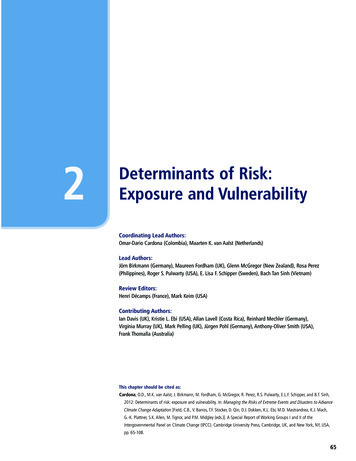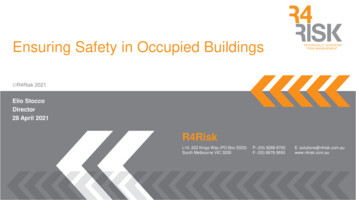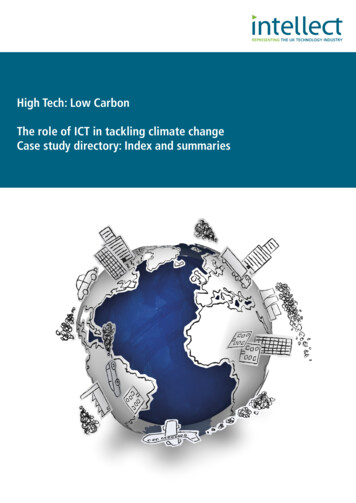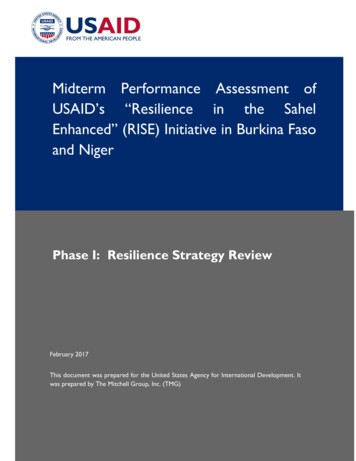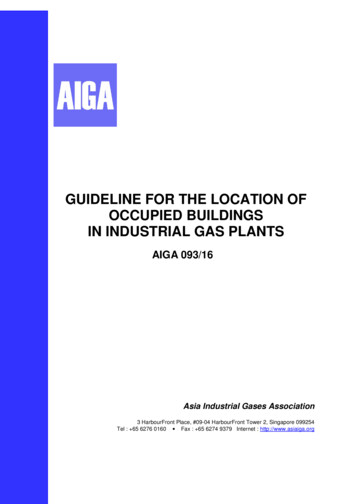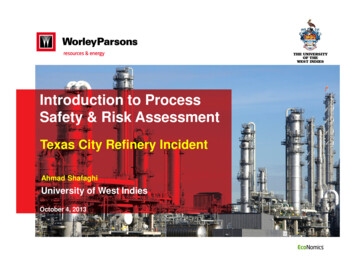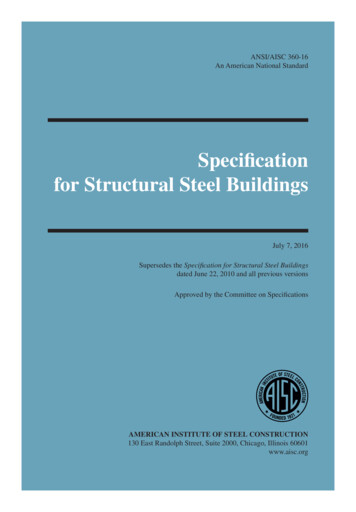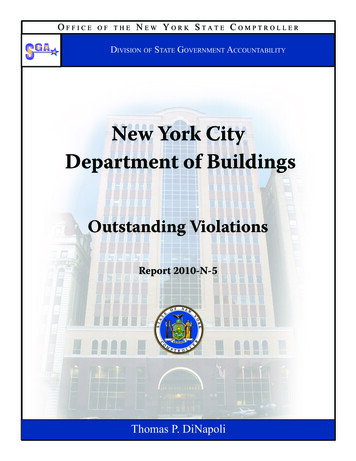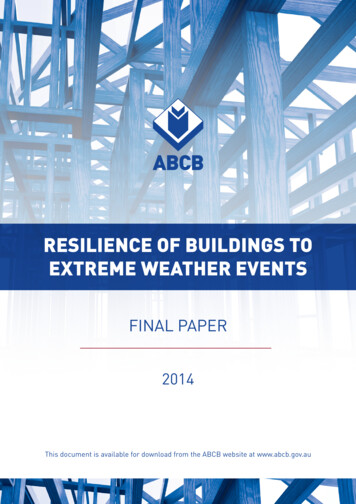
Transcription
RESILIENCE OF BUILDINGS TOEXTREME WEATHER EVENTSFINAL PAPER2014This document is available for download from the ABCB website at www.abcb.gov.au
Contents1Introduction. 22Background . 332.1ABCB . 32.2Policy setting . 32.3ABCB Roundtable . 52.4Stakeholder Consultation . 5Productivity Commission Recommendation to include Climate Change Adaptation on ABCBWork Program. 63.1456ABCB Work Program and Adequacy of NCC . 74.1Climate related natural hazards currently addressed by NCC . 74.2Financial benefits of climate related natural hazards addressed by the NCC . 84.3Hazards not addressed by NCC . 94.4Impact of climate changes on these hazards . 124.5Other impacts on hazard risks . 134.6Limitations on the NCC to address resilience to extreme weather events . 144.7ABCB Achievements in 2012-13. 144.8ABCB Future Work Program . 15ABCB’s 2010 Report on Climate Change. 155.1Report Background. 155.2Main findings of the Report . 155.3Role of BCA in addressing community resilience to climate change . 165.4Further investigation and research needs . 175.5What has the ABCB done to date in addressing the investigation and research needsidentified in the 2010 report? . 17Impact of NCC changes in short/medium term . 196.178Response to Productivity Commission Recommendation regardingtransparency/identification of climate change related work on the ABCB work program . 6Identify State/Territory triggers regarding work on existing building/plumbing systems . 19Impediments/limitations on amending the NCC for resilience to extreme weather events . 237.1Need for robust consistent data . 237.2Government/community support . 237.3Affordability . 237.4Opportunity to differentiate between residential and non-residential buildings and new andexisting buildings . 23Alternatives to NCC dealing with resilience to extreme weather events . 268.1Identify alternatives . 260
8.29Investigate international responses . 27Building and Planning working cooperatively . 319.1Planning and Building - Background . 319.2Possible improvements . 3210. Key messages . 3710.1 Summary of key messages relating to ABCB’s position and activities on resilience toextreme weather events . 3711. Summary of Conclusions resulting from Stakeholder responses . 3912. Summary of Recommendations resulting from Stakeholder responses . 4113. References . 42Appendix A. 43Appendix B . 451
1 IntroductionEffective resilience to extreme weather events (or extreme climate related natural hazards)involves a number of strategies across all levels of government, business andcommunities. These strategies include consideration of settlements and infrastructure,emergency planning and response, insurance, and human health. For the purpose of thispaper, consideration is limited to buildings, structures, and plumbing systems, which comeunder the domain of the Australian Building Codes Board (ABCB) and the NationalConstruction Code (NCC).To provide an understanding of what ‘resilience’ means for the purpose of this paper, thefollowing definition contained in the Intergovernmental Panel on Climate Change (IPCC)2012 report Managing the Risks of Extreme Events and Disasters to Advance ClimateChange Adaptation 1 is useful.“Resilience: The ability of a system and its component parts to anticipate, absorb,accommodate, or recover from the effects of a hazardous event in a timely and efficientmanner, including through ensuring the preservation, restoration, or improvement of itsessential basic structures and functions.”Not to be confused with property protection as an outright objective, a critical futurechallenge facing the ABCB is ensuring that the NCC contains appropriate standards forbuildings and plumbing systems to be sufficiently resilient in the face of natural hazardsaffected by extreme weather events, which may change over time. This is not, however, anew concept for the ABCB.The ABCB's mission, as outlined in the Intergovernment Agreement (IGA) 2, referencessustainability in the design, construction and performance of buildings. In turn this isreflected in the NCC requirements for new buildings and plumbing systems to be designedand constructed to withstand extreme climate related natural hazard events, including windand cyclones, rainfall, snow, bushfire and flood, as appropriate to their location.The ABCB has traditionally relied on historic climate and weather data when settingstandards for the resilience of buildings, structures and plumbing systems facing extremenatural hazards and extreme weather events. In addition, the ABCB has promptlyinvestigated natural disasters to determine whether the current NCC provisions areappropriate and has developed new provisions where required.Changes to the NCC are subject to compliance with Council of Australian Government(COAG) best practice regulatory principles; this includes a cost benefit analysis, regulationimpact assessment (RIS) and consideration of available data and research. However,more recently the ABCB is seeking to utilise scientifically based climate projections suchas in its review of wind standards for construction in cyclone affected areas.Further, the COAG National Adaptation Framework, the 2011 COAG National Strategy forDisaster Resilience, as well as the Productivity Commission Report into Barriers toEffective Climate Change Adaptation all recommended that the ABCB should continually12012: Managing the Risks of Extreme Events and Disasters to Advance Climate Change Adaptation. A Special Reportof Working Groups I and II of the Intergovernmental Panel on Climate Change [Field, C.B., V. Barros, T.F. Stocker, D.Qin, D.J. Dokken, K.L. Ebi, M.D. Mastrandrea, K.J. Mach, G.-K. Plattner, S.K. Allen, M. Tignor, and P.M. Midgley(eds.)]. Cambridge University Press, Cambridge, UK, and New York, NY, USA, 582 pp.2http://www.abcb.gov.au/ -2012-IGA.pdf2
monitor climate related hazards and review the NCC to ensure the standards areappropriate for the risk environment, taking climate change into account.2Background2.1ABCBThe ABCB is a COAG standards writing body that is responsible for the NCC, whichcomprises the Building Code of Australia (BCA) and the Plumbing Code of Australia (PCA)(refer Figure 1 which displays the NCC Code Series). COAG has signalled its intent tocombine all onsite building regulation into the NCC provided the benefits outweigh thecosts, with gas and telecommunication regulation currently being assessed and electricallikely to be considered in future.Figure 1: National Construction Code (NCC)The Board is a joint initiative of the Commonwealth, State and Territory governments andwas established by an IGA signed by the Commonwealth, States and Territories on 1March 1994. A new IGA was signed by Ministers, with effect from 30 April 2012.The Board’s mission is to address issues of safety and health, amenity and sustainabilityin the design, construction and performance of buildings. It is also a regulatory reformvehicle for COAG.The Board consists of an independent Chairman, up to five industry representatives, arepresentative of the Commonwealth Government, senior executives responsible forbuilding regulatory matters from all State and Territory Governments, and a LocalGovernment representative. The ABCB reports directly to the CommonwealthGovernment, State and Territory Ministers responsible for building regulatory matters, andprovides a vital link for the building industry between building practice and Governmentbuilding regulatory policy (note that reference to building here includes plumbing).The BCA and PCA are national codes which are developed and maintained by the ABCBon behalf of the Commonwealth and the State and Territory governments, who each havestatutory responsibility for building and plumbing control and regulation within theirjurisdiction. Both codes contain the minimum necessary requirements for buildingconstruction and plumbing in Australia.2.2Policy settingThere are a number of policy expectations and boundaries placed upon the ABCB thatimpact on the way the ABCB is able to deal with these future challenges. At a nationallevel these include:3
The IGA of 30 April 20123 which provides for the on-going operation of the ABCBand which gives expression to the COAG policies for regulation of the design andconstruction of new buildings and new building work.COAG Principles of Best Practice Regulation4 (2007).COAG National Climate Change Adaptation Framework 5 (2007).COAG National Strategy for Disaster Resilience 6 (2011).Productivity Commission Report - Reform of Building Regulation (2004)7.Productivity Commission Report - Barriers to Effective Climate Change Adaptation(2012)8.Productivity Commission –Natural Disaster Funding Arrangements- Issues Paper(May 2014)9The policies of different governments.Societal expectations.Availability of dataOne of the main objectives of the ABCB under the IGA is to ensure that the NCCrequirements are as far as practicable nationally consistent. This does not mean, however,that 'one size fits all' because different locations can have geographic, climatic or otherdifferences, but the overall risk levels to the community should be reasonably similar.The IGA and the COAG best practice regulation guidelines require the ABCB to undertakea RIS for every significant change to the NCC, which includes an assessment of netbenefits and costs, and justification for the most appropriate option. The RIS must becleared by the Government's Office of Best Practice Regulation, which also determines theapplicable discount rate. The RIS informs the decision making process of the Board.A 2009 review for the Commonwealth Government 10 found that ‘standards for buildingdesign and construction do not currently reflect the potential impact of climate change’.The review recommended that ‘governments and industry be open to the potential toreflect climate change adaptation risks within the National Construction Code, where suchinclusion can be justified in regulation impact statement analysis’.The COAG National Adaptation Framework recommended that ‘the ABCB considerclimate change as part of periodic reviews’ of the building code. It proposed that‘information used to determine vulnerability of settlements to climate related hazards (suchas floods, bushfires, cyclones and coastal inundation)’ should be reviewed'11.3http://www.abcb.gov.au/ OAG best practice guide 2007.pdf5COAG 2007, National Climate Change Adaptation Framework, p.18, Canberra6COAG 2011, National Strategy for Disaster Resilience: Building Our Nation’s Resilience to Disasters, p.12, Canberra7Productivity Commission 2004, Reform of Building Regulation, Research Report, Productivity Commission,November8Productivity Commission 2012, Barriers to Effective Climate Change Adaptation, Report No. 59, Final InquiryReport, aster-funding/issues41011ACG (Allen Consulting Group) 2009, Review of the Intergovernmental Agreement for the Australian Building CodesBoard, Final Report, p.iv, March, Canberra.COAG 2007, National Climate Change Adaptation Framework, p.18, Canberra.4
The 2011 COAG National Strategy for Disaster Resilience established a priority outcomethat ‘building standards and their implementation are regularly reviewed to ensure they areappropriate for the risk environment’ 12.The Productivity Commission 2012 Report into Barriers to Effective Climate ChangeAdaptation13 (the Productivity Commission Report) identified regulatory and policy barriersto effective climate change adaptation together with high priority reforms to address thesebarriers.More recently, on 9 May 2014, the Productivity Commission released an issues paper 14 aspart of its inquiry into the effectiveness and sustainability of Australia’s natural disasterfunding arrangements. The Commission has been asked to assess the full scope ofcurrent Commonwealth, state and territory expenditure on natural disaster mitigation,resilience and recovery and to identify reforms which achieve an effective and sustainablebalance between natural disaster recovery and mitigation funding to help communitiesbetter prepare for disasters. The issues paper identifies that Deloitte Access Economics(2013) estimated that the annual economic cost of natural disasters would rise from 6billion in 2012 to 12 billion by 2030 and 23 billion by 2050. It also estimated thatincreased Australian Government expenditure on pre disaster resilience (of around 250million per year) would reduce these costs by more than 50 per cent by 2050. Itrecommended increased identification and prioritisation of mitigation activities.The Productivity Commission draft report ‘Inquiry into Natural Disaster FundingArrangements’ (released September 2014) is generally supportive of how the ABCB andthe NCC deal with natural disasters. The draft report states “overall, Australia’s buildingstock is of a high quality and building regulations are effective in reducing the impacts ofnatural disasters. They are regularly reviewed and updated to ensure they reflect a currentunderstanding of natural disaster risk. The use of rigorous cost–benefit analysis andreview processes provides a strong foundation for natural disaster risk to continue to beappropriately incorporated into building regulations.” A final report to Government isexpected in December 2014.2.3ABCB RoundtableThe ABCB held a Climate Change Adaptation roundtable in Melbourne on 17 April 2013 toassist the Board further develop a strategy for improving the resilience of buildings andplumbing systems in the face of extreme weather events and a changing climate.Considerations included natural hazards, energy, water and material use. Fourteen highlevel external stakeholders from industry, research institutions and government alsoattended to inform the discussion. The roundtable outcomes (refer Appendix A) have beenused to inform the content of this paper.2.4Stakeholder ConsultationOn 4 April 2014, the ABCB issued a Media Release advising that it had released adiscussion paper on Resilience of Buildings to Extreme Weather Events (available on theABCB website). The purpose of the paper was to inform stakeholders of the ABCB’spreliminary views on resilience to extreme weather events, to seek feedback fromstakeholders and obtain responses to a number of questions to help inform the ABCB on12COAG 2011, National Strategy for Disaster Resilience: Building Our Nation’s Resilience to Disasters, p.12,Canberra.13Productivity Commission 2012, Barriers to Effective Climate Change Adaptation, Report No. 59, Final InquiryReport, Canberra.14http://www.pc.gov.au/ data/assets/pdf file/0007/136429/disaster-funding-issues.pdf5
the appropriate way forward. The stakeholder feedback also assisted the development ofthe final document. The closing date for comment was 1 July 2014, although a number ofsubmissions were received and accepted after that date. The media release was pickedup by a number of media outlets and industry organisations.A total of 31 submissions were received from Government agencies, industry, insurance,education, research and environmental organisations, material suppliers and individuals(refer Appendix B for the list of organisations). A summary of stakeholder responses,together with conclusions and recommendations resulting from the responses are includedin this paper.3Productivity Commission Recommendation to include ClimateChange Adaptation on ABCB Work Program3.1 Response to Productivity Commission Recommendation regardingtransparency/identification of climate change related work on the ABCB workprogramThe Productivity Commission Report into Barriers to Effective Climate Change Adaptationacknowledged that the ‘ABCB has recently undertaken work to consider the implications ofclimate change for the NCC. This included work on assessing the need to update the NCCto reflect the impacts of increased cyclone intensity and floods. The Commissionacknowledged that ABCB has indicated that it intends to consider climate change impactsin its future work.’The Commission further considered there may be potential to improve the transparency ofthis process. ‘In particular, there is currently no publicly available work plan published bythe ABCB explaining how climate change will be incorporated into the NCC, nor is there aformal requirement for the Board to consider climate change in its reviews of the NCC.’The Commission recommended (Recommendation 10.1): ‘The Council of Australian Governments’ Building Ministers’ Forum should provideformal direction to the Australian Building Codes Board to:o monitor projections of climate change risks to buildings; ando revise the standards in the National Construction Code to take into accountthese projections where this delivers a net benefit to the community.This body of work should be transparently and formally incorporated in theAustralian Building Codes Board’s annual work programs.’The Commonwealth Government's response to Recommendation 10.1 was to note therecommendation and agree that managing the risks of climate change to existingsettlements is a significant issue that requires cross-jurisdictional cooperation and furtherinvestigation. Early planning will reduce future costs, and there is a clear need forcommunity engagement on the acceptable levels of risk for public and private assets. TheCommonwealth Government also agreed to consult with State and Territory governmentson the best way to address this issue.Importantly, the Commission did not identify any barriers preventing the ABCB takingclimate change into account when amending the NCC. The Commission considered: ‘The current objectives of the NCC do not restrict building regulators incorporatingclimate change risks into the code.6
The current process of regulatory impact analysis for changes to the NCC isappropriate.’4ABCB Work Program and Adequacy of NCC4.1Climate related natural hazards currently addressed by NCCBuildings are currently designed and constructed in accordance with the NCC to withstandclimate related natural hazards such as cyclones and extreme winds, intense rain,bushfire, snow and flood, as appropriate to their location (refer Figure 2 which displays theABCB Flood Standard and Handbook available on www.abcb.gov.au). These hazardsimpose loads and risks to buildings determined mainly by historic records and post eventanalysis, from which design events with annual probabilities of exceedance are specified.Figure 2: ABCB Standard and Handbook for Construction of Buildings in FloodHazard Areas 15,16Building standards have undergone constant review, particularly after major hazard eventsand via research, to ensure adequate levels of safety and health are maintained for thecommunity. Where the building standards proved to be inadequate, as identified in thewake of Cyclone Althea in 1971 and Cyclone Tracy in 1974, they were subsequentlyupgraded (refer Figure 3 for example of damage caused by Cyclone Tracy impacting onDarwin).Figure 3: Example of damage - Cyclone Tracy (Source: BoM)These improved standards for high wind design were later demonstrated to be satisfactoryas evidenced by the small number of building failures resulting from Cyclones ources/publications/ 20Training/Standards/130214%20Flood%20Standard ation-eventsresources/publications/ rd%20Edition.pdf7
which affected northern WA in 1999, and Cyclones Larry and Yasi which affected northernQld in 2006 and 2011 respectively. However, the largest problem identified by recentcyclone investigations relates to pre-1980 buildings that were designed in the main tolesser standards and which have often been weakened by material degradation andinadequate maintenance (refer Figure 4 for example of damage to older housing causedby Cyclone Yasi).Figure 4: Example of damage to older house - Cyclone Yasi (Source: JCU CTS)As noted in the Productivity Commission Report, the ABCB has undertaken a study intothe impact of climate change on the BCA 17. The Report finds that by and large, buildingsdesigned and constructed in accordance with the current BCA are likely to be reasonablyadequate for climate related hazards anticipated in 50 years- time, associated with a lowemissions scenario. If the climate changes in accordance with high emissions scenarioshowever, the current BCA is likely to be deficient in some areas.Whatever the emission scenario, potential climate change impacts at both a regional andnational level require constant monitoring and review to ensure the NCC's establishedlevel of safety is proportional to the likely hazard intensity and resultant risk of damage.4.2Financial benefits of climate related natural hazards addressed by the NCCThe fact the NCC currently addresses a number of climate related natural hazards throughwhat have been adjudged to be proportional minimum performance requirements, resultsin both significant social benefits and financial benefits for the Australian economy.For example, a report by Risk Frontiers, Macquarie University in December 2007 for theABCB entitled ‘Financial benefits arising from improved wind loading constructionstandards in Tropical-Cyclone prone areas of Australia’, 18 found that ’ the improvedbuilding standards have been enormously successful with our calculations suggesting thatthey have been responsible for reducing annual average cyclone-related losses by nearlytwo thirds”. The report estimates that this equates to a present value benefit of future lossreductions equalling AUD14.2 billion. It is anticipated that additional significant financialbenefits will also accumulate from the other climate related natural hazards addressed bythe NCC.17ABCB (Australian Building Codes Board) 2010, An Investigation of Possible Building Code of Australia (BCA)Adaptation Measures for Climate Change, December, Canberra.18McAneney, J., Crompton, R., and L. Coates, 2007. Financial benefits arising from improved wind loadingconstruction standards in Tropical-Cyclone prone areas of Australia. Risk Frontiers, Macquarie University. Reportprepared for Australian Building Codes Board.8
4.3Hazards not addressed by NCCThe main objective of the NCC is life safety and not property protection. However, a levelof property protection is often achieved as a consequence of addressing life safety. Forexample, a house should be able to provide reasonably safe shelter for occupants during acyclone, bushfire or flood. In the process of providing safe shelter, the objective is for thebuilding to remain intact.While the bulk of the building may as a consequence be protected, this level of protectionmay not extend to building contents. For example, during a cyclone or flood, water mayaffect the non-structural elements leading to failure of these elements (e.g. plasterboardceiling or wall linings), which could cause additional contents damage.The NCC currently does not cover hail, storm tide or have specific requirements relating toheat stress. However, for heat stress, the NCC energy efficiency requirements wouldmoderate the impacts of extreme heat within buildings that have been built tocontemporary energy efficiency standards, resulting in reduced risk of heat stress forbuilding occupants.Some of the largest insurance property losses result from hail damage (e.g. the 1999Sydney hailstorm). However, any proposed changes would need to pass regulation impactanalysis. It is unlikely it would be cost effective to require all external building materials toresist hail impact, taking into account the localised nature of such storms, the cost ofupgrading or restricting certain building materials, and the low risk to life safety.Storm tide is potentially a very high risk in low lying coastal communities, especially thosesubject to the risk of cyclones (refer Figure 5 for example of housing impacted by stormsurge caused by Cyclone Yasi). However, it would be very costly and restrictive to designand construct buildings to resist storm surge because of the significant water forcesinvolved. Restricting development in high hazard areas via planning controls may providea more realistic solution.Figure 5: Example of storm surge damage– Cyclone Yasi (Source: JCU CTS)Nevertheless, taking into account the Productivity Commission’s report on Barriers toEffective Climate Change Adaptation, the ABCB could include hail, heat waves and stormsurge in its future work program, undertake investigations of each hazard, developpossible solutions and subject them to the RIS process.It would be unwise to commit to projects of this nature, however, without consulting morebroadly, establishing an evidence base and better understanding the capacity of the NCCto provide meaningful and pragmatic responses. It is also doubtful, given the current datagaps and likely cost implications, that a RIS would provide a net benefit.9
Rather than undertake the exercise, it may be more appropriate for the ABCB to monitorthese hazards, the data and stakeholder views, to determine if and when an investigationof any new hazards would be appropriate.Another possible option is for the ABCB to develop information Handbooks on thesehazards to provide non-mandatory advice on building solutions to help mitigate thesehazards.As mentioned above, recognising the inter-operability of building and planning controls fornatural hazard mitigation is crucial, not only to ensure the correct geographic locations areidentified for the application of building standards, but also because the best way to reducerisk to life and property is to determine where buildings should or shouldn’t be built in thefirst place.It is also important to note that the vast majority of buildings that are highly exposed tonatural hazard events already exist. The NCC does not apply retrospectively unlessrequired by State and Territory laws (such as in the case of swimming pool fences). Thismeans it will take a long period of time for the existing stock to be replaced orincrementally improved as owners undertake renovations that require the building to meetthe current requirements of the NCC.The ABCB sought stakeholder feedba
Effective resilience to extreme weather events (or extreme climate related natural hazards) involves a number of strategies across all levels of government, business and communities. These strategies include consideration of settlements and infrastructure, emergency planning and respo

